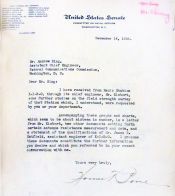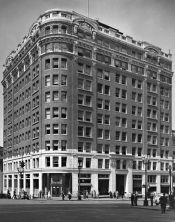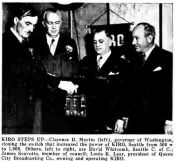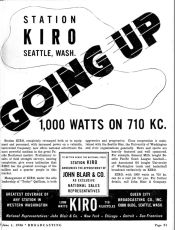|
www.theradiohistorian.org
Copyright
2023 - John F. Schneider
& Associates, LLC
[Return
to Home Page]
(Click
on photos to enlarge)
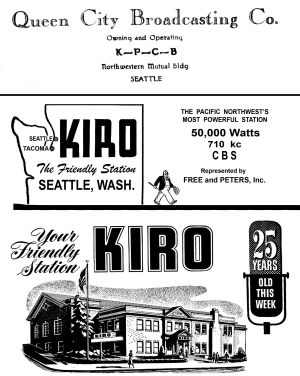
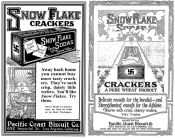
Advertisements by the Pacific Coast Biscuit Company. The
company's trademark, a swastika, quickly went out of favor in the late
1930's.
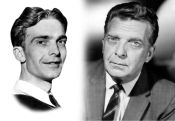
Chet Huntley - 1930 and 1968.
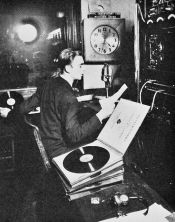
Here is Chet Huntley at KPCB in 1934, producing a low-budget opera
program. Phonograph records provided the music plus the sound
effects of a live performance. ("Puget Sounds" by Dave Richardson)
Saul
Haas was the president and major stockholder of KIRO from 1934 to
1963. He was primarily responsible for the station's rise from a
small station to a Northwest powerhouse.
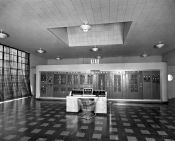
KIRO's completed 50 kW transmitter - Western Electric model
401-A. It was the factory protytpe, serial number 1.
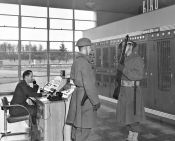
After Pearl Harbor, the KIRO transmitter was declared a strategic site
and was guarded by National Guardsmen 24-hours daily. James
Hatfield is on the telephone.
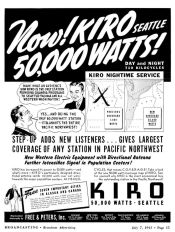
A trade magazine advertisement promoting KIRO's increase to 50,000
watts,1941.
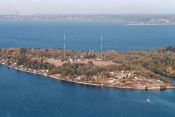
The KIRO towers on Maury Island -
a recent photo by Jerry Burling.
|
|
From Soda Crackers to Radio
The Pacific Coast Biscuit
Company was a part of the Centennial Mills
(Krusteaz Brand), which operated a flouring mill on East Marginal Way
in
Seattle in addition to several other locations around the country. Moritz Thomsen (1850-1932) was the
multi-millionaire
president of Centennial Mills. In 1927,
after competitor Fisher Flouring Mills put KOMO on the air in Seattle,
Thomsen
felt the need to match his competitor’s radio activities. On April 1, 1927, he debuted KPCB, just
four months after KOMO began broadcasting.
The KPCB call letters were an acronym for “Pacific Coast
Biscuit”.
KPCB
broadcast from a tiny studio in the Central Building, with its 50-watt
Western Electric transmitter atop the Pacific Biscuit mill at 4111 East
Marginal
Way. The first frequency was 521 meters
(575 kHz). The inaugural program
included an address by Seattle Mayor Bertha K. Landes, and then music
by a
string quartet and an eight-piece concert orchestra. KPCB
called itself the “Snowflake Station”, promoting the company’s Snowflake soda crackers.
In June of
that year, the newly-formed Federal Radio Commission moved
KPCB to 1300 kHz and required it to share that frequency on a
50/50-time basis
with KGCL, another Seattle station that was owned by radio pioneers
Louis
Wasmer and Archie Taft. Both stations
were relocated to 1210 kHz in 1928, and KPCB increased power to 100
watts at
that time. For its part of the
time-sharing schedule, KPCB was on the air Mondays, Wednesdays and
Friday until
4:00 PM, at which time KGCL took over the frequency.
On Tuesdays, Thursday and Saturdays, this
arrangement was reversed. The two
stations also divided time equally on Sundays.
This
division of time meant that neither station could attract a
sizeable audience or much advertising revenue. Although KPCB was owned
by a well-financed corporation, Pacific Biscuit never invested the kind of money
that Fisher
put into KOMO, and it was always the butt of local jokes for its lack
of funds
to buy equipment or replacement parts. As
one example, when it needed to make a remote
broadcast, the station’s only
microphone would be rushed to the remote location by taxi while
phonograph
records were played to cover the air time.
Its programs were second-rate, often originating from
transcription
recordings.
In 1929,
Wasmer and Taft reorganized KGCL under the corporate name
Wescoast Broadcasting Company and acquired an interest in KPCB. Their plan was to create a regional network
of Washington stations, with KPCB covering the Seattle area. KGCL was moved to Wenatchee and the call sign
changed to KPQ. In Wenatchee, KPQ
operated with 50 watts full time on 1500 kHz, while KPCB moved down the
band to
650 kHz where it was put on a limited daylight schedule to protect WSM
in
Nashville. This meant the station stayed
on the air until 7:30 PM in the summer months, but went off at 4:15 PM
in
December.
In 1929, KPCB
moved its transmitter to the new ten-story United Shopping
Tower at 217 Pine Street. A pair of
125-foot towers was erected on the roof, with a six-wire cage antenna
suspended
between them.
The
agreement with Wasmer and Taft apparently was short-lived, because
KPCB was reorganized in November, 1930, under the name Queen City
Broadcasting
Corporation with 2,500 shares of stock primarily in the hands of the
Thomsen
family. Moritz Thomsen, the family
patriarch, died in 1932 at the age of 82, and family members likely
continued
to manage the flour mill and radio station.
In 1934, at the depths of the
Depression, KPCB hired a young University
of Washington graduate named Chet Huntley for just $15 a week in cash
plus free
rent and meals, which were obtained in exchange for advertising trades
with an
apartment building and a restaurant. In
addition to announcing programs, Huntley would buy a newspaper on his
way to work
and rewrite stories for the station’s news broadcasts.
In 1935, Huntley’s request of a raise from
$15 to $25 a week was declined – he was told the station really
couldn’t afford
the $15. (Yes, this was the same Chet
Huntley who later became an NBC network news co-anchor.)
Also in
1934, KPCB became a part of a program-sharing arrangement with
KMO, KXRO, KVOS and KXL, called the Pacific Northwest Network,
Saul Haas
Saul Haas
(1896-1972) was born in New York City, the son of Romanian
Jewish immigrants. His experiences as an
immigrant and laborer inculcated in him a pro-labor, liberal slant from
an
early age. In 1918, he came west and
joined
the Portland News as a reporter. After
that, he tried his hand at running a newspaper in Port Angeles before
returning
to New York to work for the Hearst International News Service. In 1921 he joined the staff of the Union
Record, owned by the Seattle Labor Council, buying out the paper in
1925 and continuing as its managing editor
and a
minority stockholder until it folded in 1928.
As a
political liberal with a keen interest in politics, Haas made many
influential
connections with like-minded people during his days at the Union Record. One of his closest friends was State Senator
Homer
T. Bone, a farm and labor advocate from Tacoma.
They formed an inseparable friendship that lasted a
lifetime. In 1932, he managed Bone’s
campaign for the
U.S. Senate, and saw him swept into office on the coattails of Franklin
Roosevelt’s landslide win. This briefly
took him to Washington, D.C., where he served as Bone’s administrative
assistant. Haas’ loyalty was then rewarded
with his appointment as the Collector of Customs for the Seattle Port
District. He continued to grow in
importance as a figure in the Washington Democratic Party, and was the
state
manager for FDR’s second campaign in 1936.
Haas’
involvement in radio began in 1931, when he was appointed as the
receiver for KJR’s second bankruptcy. He
took a keen interest in the power of radio to influence people. Not long after this, Moritz Thomsen’s son
Charles
had a legal run-in with Saul Haas, the director of the U.S. Customs
Office in
Seattle . As a settlement for the
skirmish, Haas was able to acquire 700 shares of KPCB stock, valued at
$20,000.
Finally, his
involvement in the station’s operation led him to arrange a purchase of all the remaining shares in the KPCB corporation, Queen City Broadcasting
Company, from
the Charles M. Thomsen Holding Company for
$12,000. On October 15, 1935, Haas
became 67% owner and vice president of KPCB. A
group of ten other businessmen held the remaining shares: Louis K. Lear, president of Green Lake State
Bank and another Haas friend, helped bankroll the station and became
its
president. John Hagen was a co-vice president.
George B. Storer, a well-known East Coast broadcaster,
held 10% of the
stock. Harold J. “Tubby” Quilliam was
hired away from KJR/KOMO to be the new general manager.
A recent Washington State College graduate, James
B. Hatfield, became the new engineer.
Changes took
place quickly once Haas was in control - he had the drive
and determination to make it a first-class station.
The studios were moved into larger quarters
in the basement of the Cobb Building, a space recently vacated by KOMO.
On October 15, 1935, Vice President
Garner and
other dignitaries attended a ceremony boosting the station’s power
from 250
to 500 watts. The same day, KPCB’s
call
letters were changed to KIRO, which Haas thought had a pleasing sound. In the following months the staff size nearly
doubled as talented people were hired away from other stations. Better programs were created, a professional
sales organization was hired, and before long KIRO was operating in the
black.
KIRO
programs were a mixture of network, local and transcription
programs. It called itself “The Friendly
Station”, adopting an informal announcing style that differentiated it
from the
formal, stuffy style of most other stations. A
station mascot character named “KIRO Looie”,
an Arabian sultan, was created for use over the air and in printed ads. An announcer in the Looie character’s voice
hosted a daily early-morning request program called “KIRO Looie’s Time
Klok Klub”. Max Dolin, the
Cuban-born former NBC network
West Coast music director, broadcast a live 30-minute live orchestra
program
every Sunday night, sponsored by Gold Shield Coffee.
A separate “home service auditorium” was
inaugurated in 1938. Seating 250 people
and featuring a model kitchen and electric organ, it was the source of
daily
cooking schools for housewives and a Saturday children’s cooking
program. In 1939, “Father Goose Comes to
Town”, written
by Dorothy Mason. presented dramatized nursery tales. Singing
station break jingles were another
innovation, with “Columbia’s Voice in Seattle” being sung to the tune
of
“Columbia, the Gem of the Ocean”. Also
that year, a 25-year-old pianist named Freeman Clark began
playing
twice weekly on KIRO. He would later team
up with Eddie Clifford, and the Clifford and Clark piano duo would be a
Seattle
radio staple for many decades.
In 1937,
CBS’s purchase of KNX in Hollywood caused domino-effect changes
of station affiliations up and down the coast. As
a part of this shakeup, Haas began
negotiations with CBS, ultimately resulting in the network moving it’s
Seattle
affiliation from KOL to KIRO. In
1938, KOL filed a lawsuit against Haas and Bone over the network
“theft”, but
it was dismissed by the courts. KIRO would carry CBS's dramas,
comedies,
news, sports, soap operas,
game shows
and big band
broadcasts during the "Golden Age of Radio"
and beyond.
The Battle for 710 kHz
Saul Haas’
close personal relationship with Senator Homer Bone gave him
a powerful friend in Washington. (While
it’s
possible that Bone may have had a business interest in the station, he
was
never a stockholder.) In any event, the
combined political influence of Haas and Bone was put to bear on the
newly-organized Federal Communications Commission. It
seems that whenever a U.S. Senator lobbied
the commissioners, locked doors magically opened.
Looking for
a solution to KIRO’s limited-hours problem, Haas and Bone
convinced the FCC to allow KIRO to “temporarily” change frequencies to
710 kHz. 710 was designated as a Class 1-A
clear-channel,
assigned to WOR in New York City. (Class
1-A meant that only one station in the country could use the frequency.) But WOR operated with 50 kW into a directional
antenna that favored a North-South direction, thus sending a lesser
amount of
power westward. Because its signal did
not reach the Western USA, Haas and Bone proposed to the FCC that KIRO
should try
operating on the 710 channel with unlimited hours and 250 watts on a
test basis
to see if any interference to WOR was reported.
The Commission granted the request, issuing a temporary
experimental
permit that was valid for six months.
That “temporary” permit would be extended every six months
for the next
five years! During that time, teams of
engineers conducted extensive tests to document KIRO’s signal coverage,
finding
no instances of interference to WOR.
The KIRO
transmitter was moved in 1936 to the top floor of the Rhodes
Department Store, using an existing rooftop antenna that had recently
been
vacated by KFOA/KOL. The power was
increased to 1,000 watts in 1937. All of
this was, of course, just “experimental”.
Although WOR
had initially agreed to the KIRO tests, it soon had a
change of heart when other Western stations also requested a chunk of
the 710
channel. KMPC in Beverly Hills,
California, which was already on 710 at 500 watts but with limited
nighttime hours
to protect WOR, now requested nighttime operation and higher power. If this was to be allowed, WOR would find itself
demoted to a secondary Class 1-B license status.
Additional pressure was applied in the form
of lobbying by CBS, which wanted better signal coverage for its two
affiliated West
Coast stations. An
additional factor was
the speculation that the FCC would allow certain 1-A clear channel
stations to
operate with increased powers up to half a million watts, a proposal
being floated by some broadcasters after WLW in Cincinnati’s
experimental
operation
at that super-power level. WOR feared
that, by allowing other stations to occupy the channel, its ability to
raise power
would be blocked. Eventually, Congress
became involved in the issue when it held contentious hearings in 1938
to
determine whether or not broadcast power levels above 50 kW would be
allowed. (Ultimately, Congress dictated
to the FCC that 50 kW would be the U.S. power ceiling, and WLW’s experimental
permit
was revoked.)
Another
issue working against WOR’s case was the international
negotiation taking place to re-order the assignment of broadcast
frequencies in
North America (the NARBA treaty). In those
negotiations, the 710 channel was to be re-classified as a 1-B
frequency, which
would allow stations in neighboring countries to use the channel.
In its 1939
article about the NARBA committee hearing, “Broadcasting”
Magazine wrote:
Making an impassioned plea
for the classification of
WOR, Newark, as a Class 1 station of the upper bracket rather than a
Class 1
duplicated station, as recommended by the committee in accordance with
the
Havana Treaty allocations, Frank D. Scott … said the only logical
reason he
could conceive for WOR’s relegation to 1-B status was “an unfortunate
and
undeserved retaliation on WOR for having consented to an
experimentation” of
the experimental use of the 710 kc channel, starting 4 years ago, by
KIRO,
Seattle, to determine whether its service in the Seattle territory
would
interfere with the normal service of WOR.
Reminding the Commission that WOR had withdrawn its
permission for the
use of the 710 kc frequency before the subcommittee started its
hearings, …
although he refused to believe it was an intentional discrimination
against
WOR, “in effect it is a definite discrimination.”
Ultimately, in November,1939,
the FCC officially demoted the 710 channel
to Class 1-B status, clearing the way for a formal modification of
KIRO’s
license to operate full time on the 710 channel, ending the station’s
experimental status. Both WOR and KIRO were given equal
Class 1-B status. At
the same time, KMPC was given a Class II
license with unlimited operation at 5,000 watts days and 1,000 watts at
night.
Those
actions immediately opened the floodgates to other applicants,
and, in 1939 and 1940, stations in Fort Worth, Ft. Lauderdale,
Minneapolis and
Kansas City all filed for the 710 frequency as Class II stations. The applications were set for hearings, but
the start of World War II froze all applications. That
left WOR, KIRO and KMPC as the sole
occupants of the frequency. Eventually,
after the war, the 710 channel was broken down further, with a several
stations
operating around the country as Class II stations, meaning they were
required
to use directional antenna systems that protected both WOR and KIRO.
“If You Can’t Get This
Station, Better Give Up”
As
mentioned, now that KIRO was formally broadcasting on 710 kHz with
1,000 watts, Saul Haas took advantage of the opening to go for even more
power. In February, 1940, he filed an
application with
the FCC to increase KIRO’s power to 10,000 watts using a directional
antenna
that would focus the station’s power north and south along the Pacific
coastline. KMPC at first objected, as it
was also planning to increase power from a new site, but the objection was
removed
when the two stations agreed to protect each other’s signals from
interference.
Shortly after
KIRO’s application was submitted, CBS announced its
intention to drop KVI as its affiliate in Tacoma the following year. KVI had just inaugurated a new 5,000-watt
tower on Vashon Island, giving it a strong signal in Seattle, and
KIRO’s planned
10,000-watt signal would cover Tacoma equally well.
The network now recognized Seattle-Tacoma as
a single radio market, and it did not want two CBS stations
competing for listeners. KVI was to be the loser.
In 1939,
Haas asked Tubby Quilliam to meet with the owners of KVI and
explore the opportunity of buying the station. He hoped to operate both
KIRO
and KVI from the KVI’s Vashon Island property. But
those negotiations went nowhere, and so in
February of 1940 he acquired 37 acres of property on Maury Island,
midway
between Seattle and Tacoma in the Puget Sound, to construct KIRO’s
directional
transmitter plant. In
October, 1940, KIRO modified its FCC application
to request 50,000 watts, which was immediately approved.
KIRO’s chief
engineer James B. Hatfield managed the entire project for
KIRO, dealing with numerous setbacks and unforeseen obstacles. Clearing of the second-growth forested plot
was
complicated by the existence of 600 stumps from the original old-growth
forest,
and it took a road-building crew nearly 4 months to finish the job. The Northwest’s rainy fall and winter weather
delayed the installation of the two towers and the burial of 21 miles
of copper
ribbon that would form the ground system. The
construction of the Art Deco transmitter building couldn’t begin until
the
ground system work was completed. Pre-war
buildups by the Department of Defense delayed
the deliveries of many materials.Western
Electric was the chosen supplier for the transmitting equipment,
and Frank McIntosh, who would later develop a line of high-fidelity
sound
equipment under his own name, became that company’s field engineer for
the
project. When
completed, the KIRO transmitter facility on Maury Island would
consume $182,000 in direct costs, and with ancillary expenses the total
project came in at over $250,000 ($5.3 million in today’s dollars).
At 11:30 AM
on June 29, 1941, KIRO raised its power from 1,000 watts
to 50,000 watts. The
formal dedication of the new KIRO signal It
began at 10:15 AM with a short show by folksinger and future Acres of
Clams
restaurateur Ivar Haglund (1905-1985). Then a dedication preview went
out,
followed by a special “Dedication Edition” of KIRO news. The formal
ceremony at 11:00 AM was broadcast coast-to-coast on the CBS network. It featured officials from CBS, the governor
of Washington State, and the mayors of Seattle, Tacoma, Everett, and other Northwest cities. Afterwards, CBS
saluted KIRO with live music by Lynn Murray and his orchestra. At 1:00 PM, Carroll Foster, voted Seattle’s
most popular announcer, hosted “Looie’s Time Klock Klub”, followed by
vocals by
the “KIRO Dream Girl”, Carola Cantrell. Also
that day, special salutes were heard from
cowboy Gene Autry, CBS orchestra leader Andre Kostelanetz, and mentions
within
several other network programs.
Wartime Radio
KIRO was now
the only 50 kW station north of San Francisco and west of
Salt Lake City - in fact, there were only three others west of the
Mississippi. At the start of World War
II, all station applications were frozen by the FCC, making KIRO the
most
powerful station in the Northwest until after the war.
After Pearl
Harbor, the Pacific Coast was considered particularly
vulnerable to a possible Japanese attack.
Blackouts were occurring periodically on the West Coast,
and the public
could be called on short notice to block out all light outside their
businesses
or residences. KIRO was declared the official northwest station for
bulletins
from 2nd Interceptor Command, and businesses and the public were
advised to
continuously monitor KIRO for these bulletins.
Within days of the declaration of war, the local commander
made a special
request to the FCC to allow temporary non-directional operation at
night, providing
better coverage to Eastern Washington. KIRO
was now on the air 24 hours a day, allowing for the broadcast of
emergency
bulletins at any time.
Because of
the strategic value of the KIRO transmitter during the war,
the government stationed national guardsmen on duty there 24 hours a
day. During construction, with war clouds
on the
horizon, many considerations had been made to protect the station against
wartime
sabotage. The thick concrete walls of
the building held a diesel generator, and a standby shortwave program
link was
put in place, in case phone or power lines to the island were cut. A 120-foot pole was erected outside the
building to serve as an emergency antenna.
KIRO’s
program emphasis during the war years was education.
A full-time education director was hired in
1942, and programs such as “Pledge Allegiance to Your Job” helped
inspire the
patriotic spirit of its audience. There
was also an emphasis on agricultural programming, as KIRO provided
better
coverage to the rural areas than other stations. One
newspaper wrote, “For almost two years,
Bill Moshier’s Farm Forum on KIRO at 7:15 AM has been a ‘must’ on the
radio
calendar of every farm family within earshot of the station.” The program presented technical information
about agriculture as well as farm news of the nation and the world.
During the
war, the CBS network carried on the most aggressive and
thorough war news coverage of any radio organization, led by Edward R. Murrow in London and a
team of
field reporters, nicknamed “The Murrow Boys”, stationed across Europe and
the
Pacific. (Murrow was a Washington native
– he grew up in Bellingham, and received his degree in communications
at
Washington State University. The
communications school at WSU is now called The Edward R. Murrow College
of Communications.)
Due to its
West Coast location, KIRO recorded the daily East Coast CBS
newscasts and special reports onto acetate disks for delayed re-broadcast
at a
more appropriate time. After being broadcast,
the used recordings were stored in the transmitter building. They represented a daily audio journal of the
developing events in the theatres of war.
After the war, KIRO donated more than 2,500 recorded disks
to the
University of Washington, establishing the Milo Ryan Phonoarchive – the world’s most complete library of World
War II newscasts.
Post-War and Television
Under Saul
Haas’ direction, KIRO grew even more after the war. The
studio facilities in the Cobb Building
were enlarged. KIRO-FM 100.7 came on the
air in 1948 – at first broadcasting a duplication of the AM station’s
programs,
but in later years developing into a separately-programmed station. There was a brief experiment broadcasting to
public buses, but KIRO finally settled for simply simulcasting its
regular AM
broadcasts on its FM station.
Since 1948,
there had only been one TV station in Seattle – originally KRSC-TV before becoming KING-TV. An FCC applications
freeze had kept other potential applicants at bay.
When the end of the freeze was announced in
1952, KIRO was planning to file an application for the TV channel 4 that
had been
assigned to Seattle. Realizing that its
studio space in the Cobb Building would not be adequate as a TV studio,
KIRO purchased
the former Queen Anne Club building at 1530 Queen Anne Ave. N. that
year. Built
in 1927, the 12,000 square foot building had a second-floor auditorium
that
could be converted into a TV studio. The
building was remodeled to house KIRO’s radio studios on the first floor
and
offices on the second floor.
But its TV
plans were stalled when competitor KOMO also filed for
channel 4, which would delay both stations' possibilities through drawn-out
hearings
with the FCC. So KIRO agreed to modify its
application to channel 7, the only other remaining VHF TV channel
authorized
for the city, and the FCC then granted channel 4 to KOMO in 1953. But then two other local radio stations – KVI
and KXA – also filed for channel 7. After
a series of hearings in Washington, the FCC decided to award the channel to KIRO
in
1954, but then both competitors appealed. The
contest for channel 7 turned into a deadlock of ugly challenges and
counter-challenges,
with KVI claiming during the Joseph McCarthy “Red Scare” period that
Saul Haas
was a communist sympathizer.
A final decision
in June of 1957 at last awarded KIRO a construction permit
to build a new television tower on Queen Anne Hill.
By this time, six area TV stations already were on
the air - three in Seattle, two in Tacoma and one in Bellingham.
In 1957,
KIRO modified its studio building to accommodate its new TV
studios, and built its TV tower on the south side of the property. KIRO radio and the corporate offices moved
across the street to 1507 Queen Anne Avenue N.
KIRO-TV went on the air February 8, 1958, although
residual KXA and KVI
appeals were still in play until the end of that year.
Because
KIRO had been CBS’s flagship radio affiliate in the Pacific
Northwest since 1937, the two companies had a close relationship.
Saul Haas used his leverage with CBS to acquire the network
affiliation for KIRO-TV. In August,
1957, CBS informed its affiliate KTNT-TV in Tacoma that it would be
moving its programs to KIRO-TV as soon as the new station began broadcasting. KTNT-TV then filed a triple-damages anti-trust suit
against CBS, Queen City Broadcasting, and Saul Haas totalling $15 million,
alleging
restraint of trade and attempt to monopolize.
The lawsuit was ultimately
unsuccessful.
Transition from Dramas to
Deejays
By the
mid-1950’s, TV was king and radio’s “Golden Age” was at an
end. KIRO-TV was a local success, but
KIRO radio was gradually transitioning from the big network programs to
the
recorded music programs of the disc jockey era. Although
stations like KJR and KOL would find
success with Top 40 rock-and-roll programming, KIRO, KOMO and most other
Seattle
stations were offering adult “MOR” music and block programming. In addition to carrying CBS's newscasts and its few remaining
dramatic programs, popular local offerings included the
Clifford and
Clark piano duo in the mornings, “Swap and Shop”, “Maury Rider’s
Turntable Show”,
the “Housewive’s Protective League” with Paul West, and the late night “Dance Time”. There were some notable
successes; during the Korean War, KIRO
broadcast several drives for blankets to send to troops overseas. And in 1956, KIRO won a prestigious Peabody
Award for a community radio series, "Democracy Is You."
In 1959,
KIRO hired Jim French away from KING to be its morning man. His popular show featured a mix of adult music
and French’s polite, conversational style.
In 1966, French moved his
morning
show to a studio on the observation deck of the Space Needle, recently
vacated
by KING’s morning man, Frosty Fowler. The
location gave him a birds-eye view of traffic movement in the city,
which
allowed for accurate and timely traffic reports.
He broadcast from the Space Needle until
leaving KIRO in 1971.
End of the Haas Era
In April of
1963, Bonneville Broadcast, a division of the Church of Latter-Day
Saints, began purchasing stock in Queen City Broadcasting. In January,
1964,
that culminated in Bonneville’s complete purchase of KIRO AM-FM-TV.
Arch Madsen became president, replaced in 1965 by
Lloyd Cooney who headed the station until 1980,
followed
by Ken Hatch. After his retirement, Saul
Haas concentrated his remaining years on the operation of the Saul and
Dayee G.
Haas Foundation , which he formed in 1963 to fund the needs of poorer
students
in the local school districts. Haas
also
served two terms on the board of the Corporation for Public
Broadcasting and
was a member of Bonneville’s board until his death in 1972.
In 1968, a
new “Broadcast House” studio building was constructed for
KIRO radio and TV at Third and Broad Streets. The
previous TV studios at the old Queen Anne
Club building were sold to Community Services for the Blind.
KIRO Newsradio 71
By the
1970’s, KIRO’s ratings as an adult music station were
declining. Finally, in 1974 KIRO switched
formats to a news-talk station, modeled after CBS’s successful KCBS in
San Francisco. It broadcast a three-hour
morning all-news
block hosted by Bill Yeend, and leased an Enstrom helicopter to air the
city’s
first air-based traffic reports, broadcast by Paul Brendle. Hourly CBS newscasts and special reports
augmented the strong local content (except for the 1973-76 period, when
it
switched to Mutual and NBC before returning to CBS.)
The new
format was a quick success, and featured personalities such as Gregg
Hersholt, Wayne Cody, and Andy Ludlum.
Jim French returned to the fold in 1991 as a midday host,
Dave Ross joined
the air team in 1978 as its afternoon anchor, and then moved to mornings after French’s retirement. At different times, KIRO was also the flagship
station for the Seattle Seahawks,
Mariners, UW Huskies, Sounders and Supersonics. KIRO
received the Edward R. Murrow award for
outstanding news programming in 1982, 1989 and 1991.
In the
1990’s, Jim French began producing regular radio drama programs
at KIRO, titled the “KIRO Mystery Theatre”, continuing a pattern he had
previously started at competitor KVI.
The popular programs were recorded before a live audience at the Museum of
History and
Industry and were carried by KIRO on Sunday nights for many years before
going into
independent syndication.
In 1975,
KIRO-FM became KSEA, broadcasting easy listening music to an
adult audience. This was changed to
adult contemporary music in 1990 as KMWX, returning to KIRO-FM in 1992.
In 1993, the
radio and TV newsrooms were briefly combined into a single
operation, but this was scrapped as a failure after only 6 months. .
In 1995,
Bonneville sold KIRO-TV to the A.H. Belo
Corporation. Now separated from its TV sister
station, KIRO AM/FM
moved iout of Broadcast House and nto new studios at 1820 Eastlake Avenue. In
1997, Bonneville sold KIRO AM/FM to
Entercom Communications (now Audacy). But
then ten years later Bonneville re-acquired KIRO
AM from Entercom in a station swap, along with Entercom’s KBSG-FM 97.3. (The original KIRO-FM is still owned by
Entercom, and is now known as country station KKWF “The Wolf”). Back in the driver’s seat, Bonneville decided
to transition KIRO’s successful Newsradio format over to the FM band,
and so
KBSG became KIRO-FM. After a year of
simulcasting its Newsradio programs on both the AM and FM stations, the
transition was completed in 2008 and KIRO AM began a sports format as
“710 ESPN
Seattle”.
Political
clout and shrewd management turned tiny KPCB into today’s AM
and FM juggernaut. The successful KIRO Newsradio format is now nearing its 50th anniversary. Undoubtedly, KIRO is
one of radio’s big success stories.
REFERENCES:
- “Broadcasting”
Magazine, (worldradiohistory.com): 9/1/34,
11/1/35, 11/1/36 ,2/15/37, 3/15/37, 10/15/37,
12/15/37, 4/1/38, 4/15/38, 5/1/38, 6/15/38, 7/1/38, 9/15/38, 11/1/38,
2/15/39, 6/15/39,
7/15/39, 9/1/39, 10/15/39, 11/15/39, 5/1/40, 6/1/40, 8/15/40, 11/1/40,
2/10/41,
7/7/41, 11/3/41, 12/29/41, 1/12/42, 1/21/52, 7/7/52, 6/15/53, 4/11/55,
6/2/58, 12/15/58
- Seattle
Post-Intelligencer 6/21/41
- Seattle
Times 1/6/97
- “History of
KIRO” by David Braun, Puget Sound Antique
Radio Association
- Saul Haas
biography, HistoryLink.org
- FCC History
Card for KIRO, www.fcc.gov
- KIRO
historical files of the FCC at the National
Archives, Washington, DC
- Personal
files of James Hatfield, courtesy of his son
Jim Hatfield Jr.
- “Good Night,
Chet,
A Biography of Chet Huntley” pages
28-30
- "Moodys
Analyses of Investments 1917” – Coast Biscuit
Co.
- KIRO Silver
Anniversary Brochure, 1952
- Queen Anne
Historical Society, https://www.qahistory.org/articles/queen-anne-club
- Wikipedia: KIRO,
KPQ, Moritz Thomsen
|
